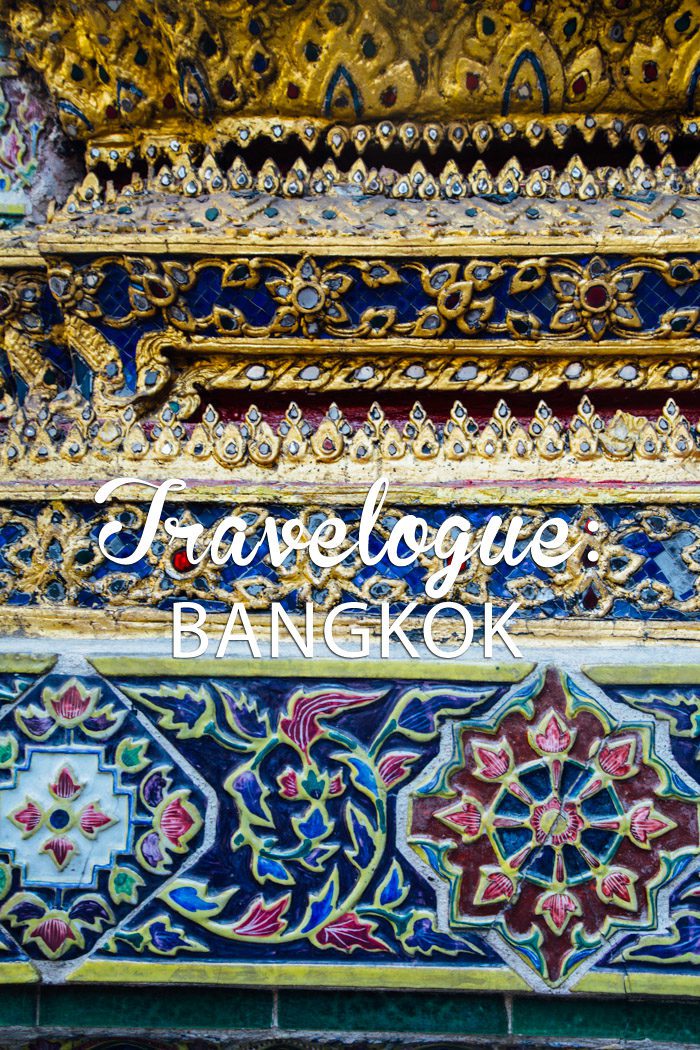
We had four nights in Bangkok, and if we’d change anything about our two weeks in Thailand it would probably be to add one more night in the city. But, frankly, we could have probably spent our entire two weeks there and still have wished for more, so at some point one just has to hope to have gained an appreciation for a place that might be enough to keep with them always. And then hope to return.
Some find Bangkok too hot, too polluted or too chaotic, but we loved its energy, the clash of its ancient culture with a modern metropolis. And the food… we never could completely get our fill.
My impression is that there’s a different Bangkok for every traveler and every budget. We spent our first two days settling in and getting re-acquainted; and then this is the Bangkok we found for the next two days with two little kids…
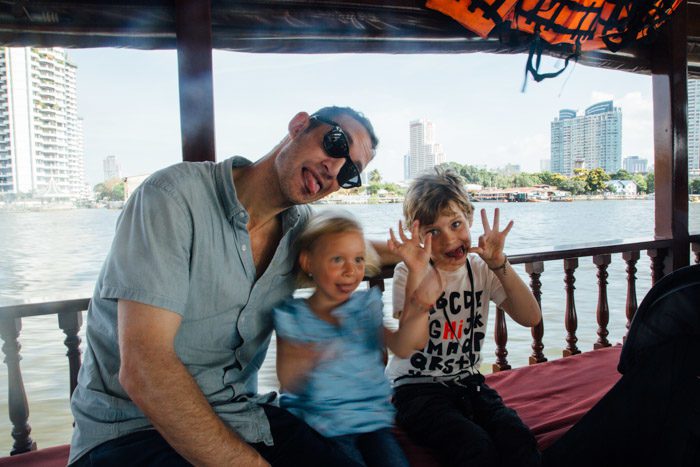
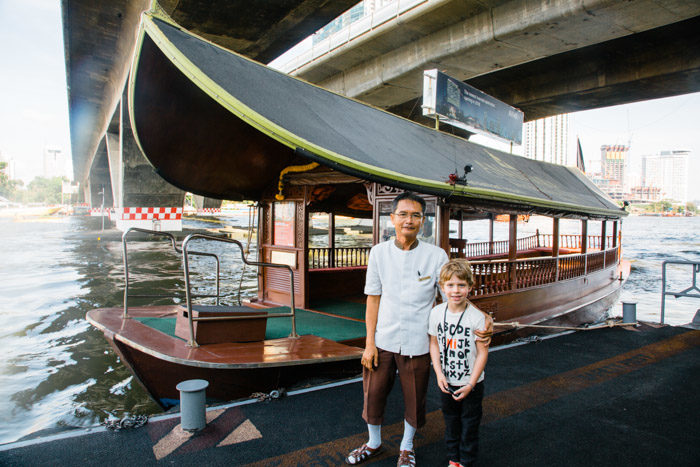
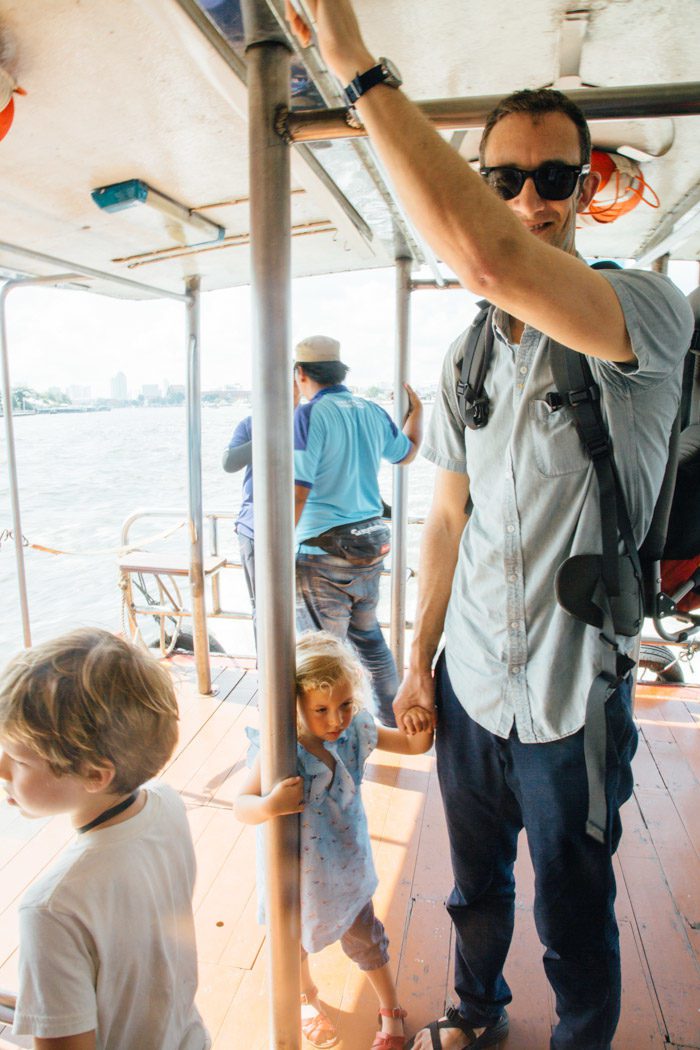
We started our third day in Bangkok with a boat journey to visit to the Grand Palace—along with everyone else, it seemed. We hadn’t really experienced any crowds until then, but the palace grounds were choked with people. Huge groups gathered to stream through the gates. It was such a surprise!
It wasn’t just tourists, however. Residents were also gathering in mass—large groups, all dressed in black, were waiting to pay their respects to the beloved King Bhumibol Adulyadej, who had died last October after more than 70 years on the throne. And stands were set up around the perimeters of the palace to accommodate and provide food and water for the visiting mourners. More than six million had come so far to visit the King, lying in state; no doubt millions more will visit before his cremation next October.
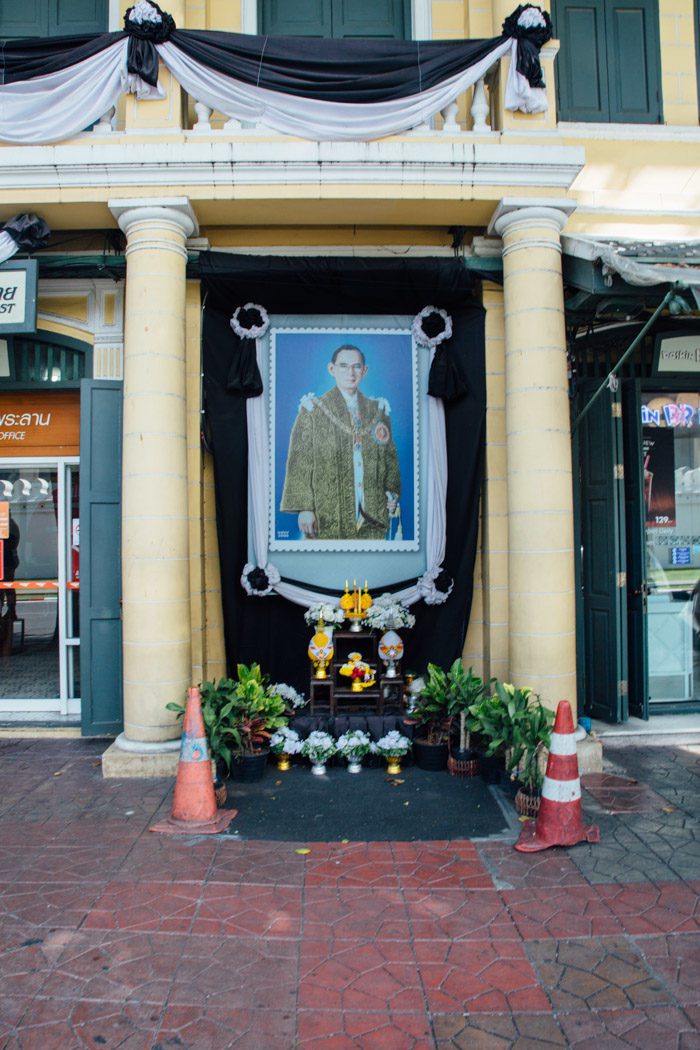
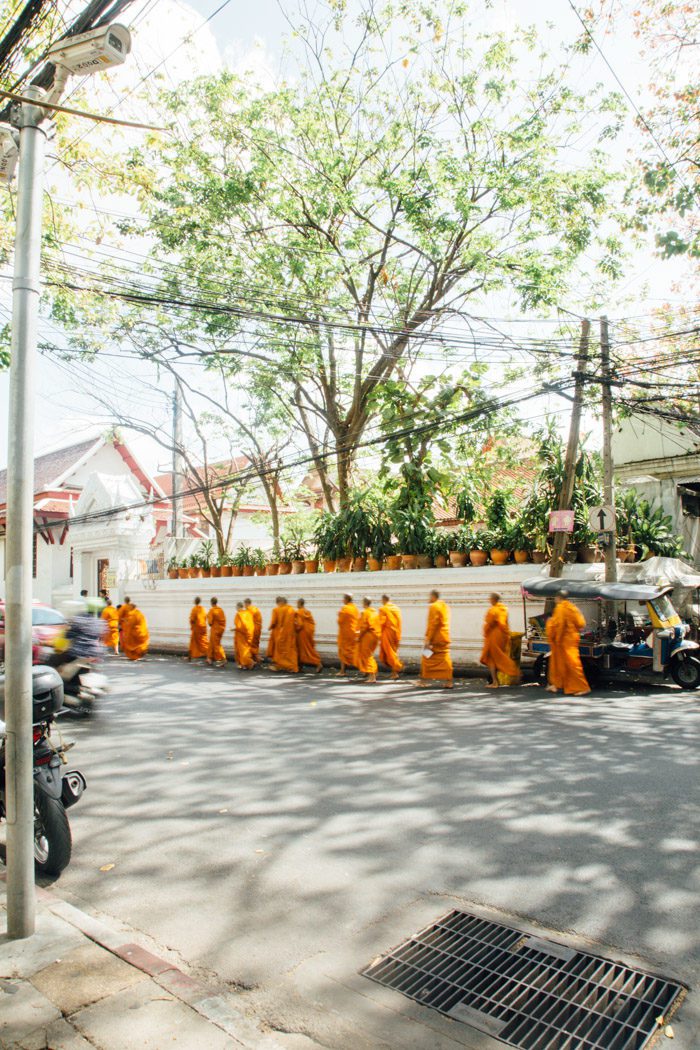
The Grand Palace is located in Ko Rattanakosin, the old quarter of the city where most of Bangkok’s major historical sites are located. There’s a road just outside the gates where we passed souvenir shops and convenience stores—most of which were selling sarongs, happy pants, and long-sleeved shirts for visitors caught unprepared. No one is allowed inside without proper temple attire.
Even in the morning, you could feel the steam rising off the pavement, and we made a few stops for cold juice along the way. The small green oranges (tangerines, perhaps) that are pressed for fresh juice make for an especially sweet refreshment, and Skyler was hooked.
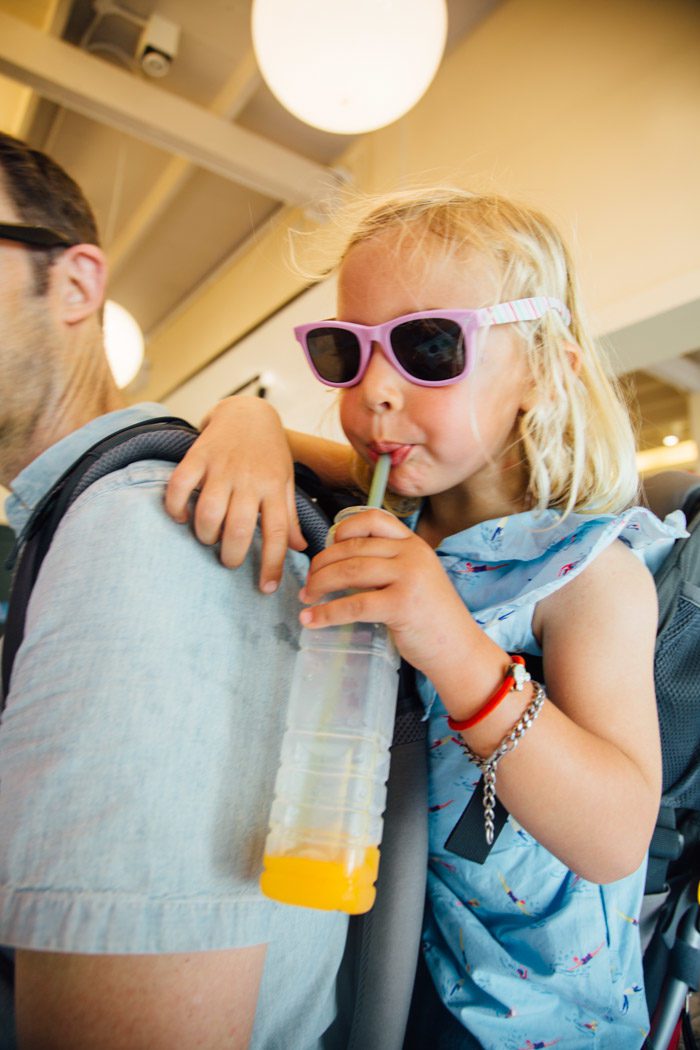
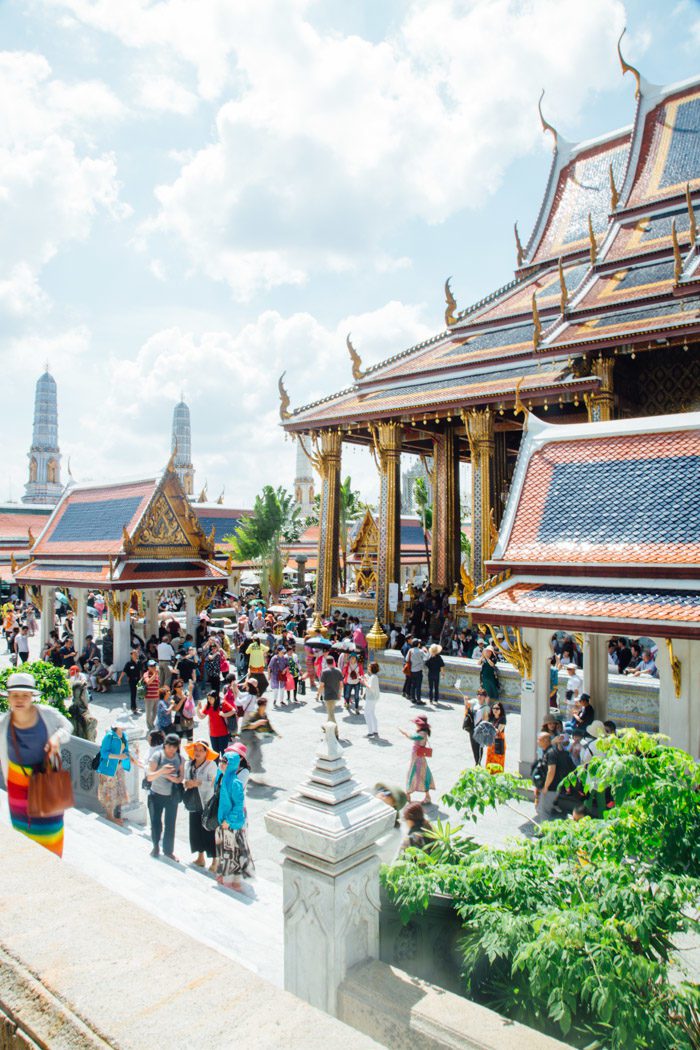
Once inside the gates, the line for tickets goes quickly as credit cards will be waved away. As most guides will warn you, don’t listen to anyone trying to sell tickets outside the gates or who claim that the palace is closed. Guides can be hired on site for an additional fee, but we decided we would just take a look around at our own pace.
There’s some debate about whether it’s better to visit the palace in the morning or the afternoon. Even if the sun were more intense later in the day, I wonder if the crowds would be less so.

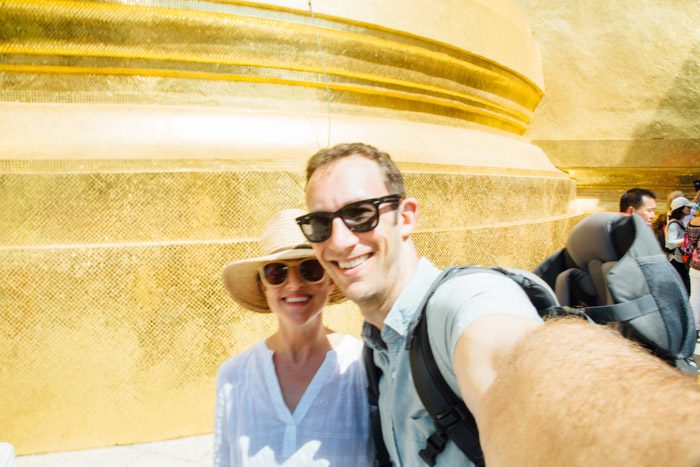
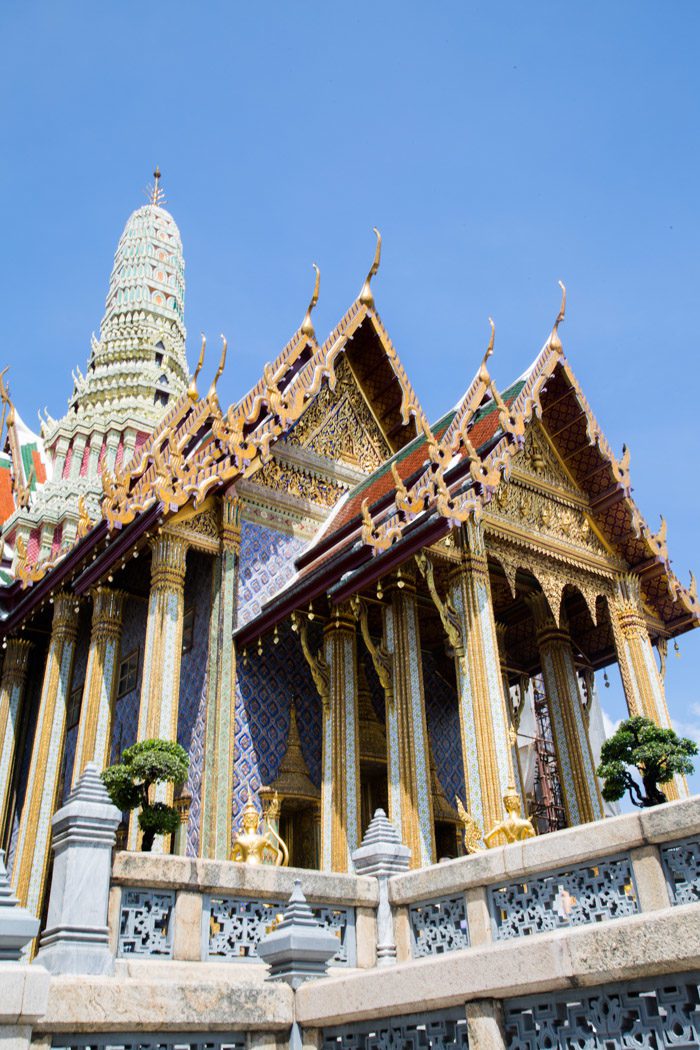
Each pavilion seemed more splendid and ornate than than the previous. I’d forgotten just how beautiful all of it is. The children are at an age where the difference between colored glass and gemstones, gilt and real gold is moot—it was if we were surrounded by treasure! Hudson loved the warriors making scary faces, the golden statues with wings and long curving fingers.
King Rama I built the complex as a walled city in 1782, when he moved the capital across the river from Thonburi, and while the grounds are open to visitors, the buildings are not.
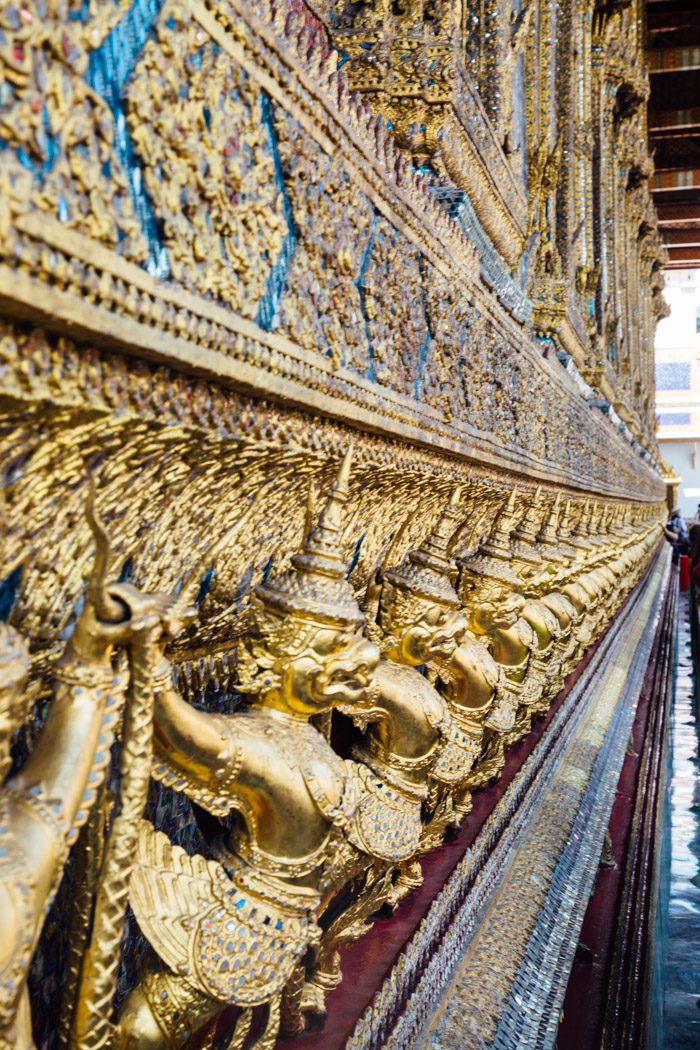


We knew we’d reached the site of the Emerald Buddha, Wat Phra Kaew—the most sacred site within the palace grounds, housed within a small temple—when we saw the piles of shoes. Despite its name, the small sculpture was carved from a single piece of Jade in the 15th century. No photos are allowed inside.
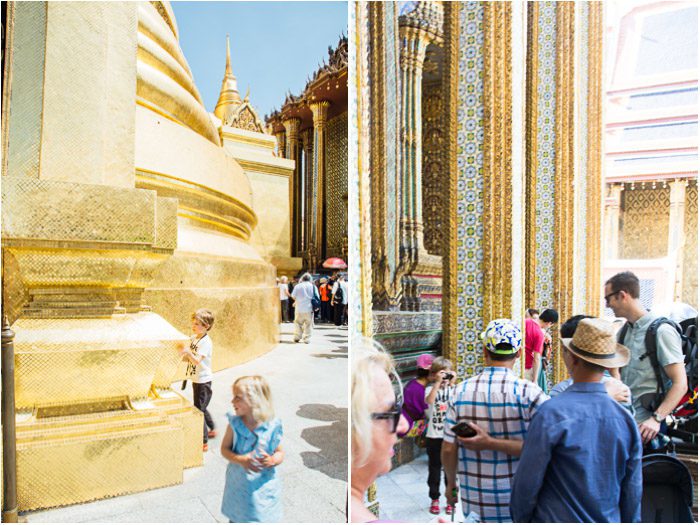

Outside, however, Hudson and these men were taking photos of one another, and soon we were all taking selfies together.
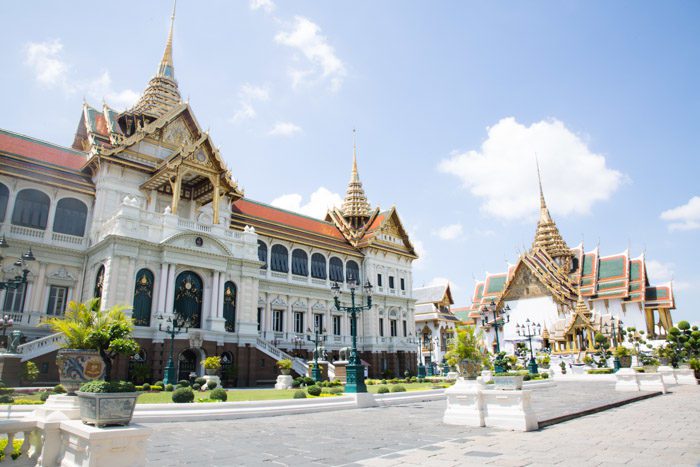
We made our way through the central area fairly swiftly, passing the beautiful Chakri Maha Prasat hall, a work of British and Thai architecture from the late 19th century, on our way out. The top of the building is a shrine room with the ashes of the last five kings and queens; the ground floor, with a collection of weaponry, is usually open to visitors but has been closed since the King’s death. Just beyond we passed through hallways filled with people wearing black and waiting to pay their respects. I tried to capture the image in my mind’s eye, realizing the uniqueness of the moment in history.
Only one building in the Grand Palace, in the gated-off eastern side of the complex, is currently used as a residence by a member of the royal family—the princess. I have to tell you that one of the highlights of our visit was when Skyler charmed one of the guards who stood by her gates. He was totally unflinching until she started waving and smiling. I looked over and caught him giving her a small smile and a wink in response!
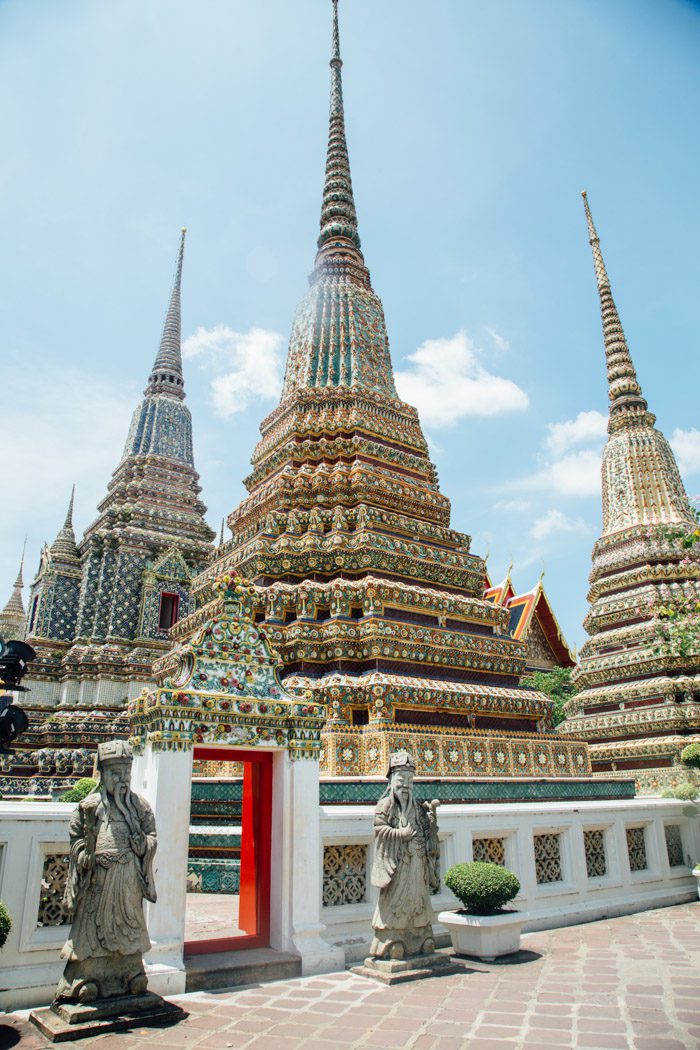

Our next stop was the nearby Wat Pho, probably the second most-visited sight in Bangkok. A temple compound of the highest royal grade, it was the official temple of Rama I who founded the Chakri lineage in 1782. It’s also the site of Bangkok’s oldest university: a monastery was founded here to teach traditional medicine. The monks still practice ancient cures, and we considered taking turns getting a Thai massage from students at the massage school—where I had my first massage (ever) on the first day of our honeymoon, ten years earlier.
It’s perhaps best known, however, as the site of the largest reclining Buddha, a depiction of Buddha entering Nirvana covered in gilded plaster and filling an entire Wat at nearly 150 feet long, with feet elaborately decorated with mother-of-pearl.


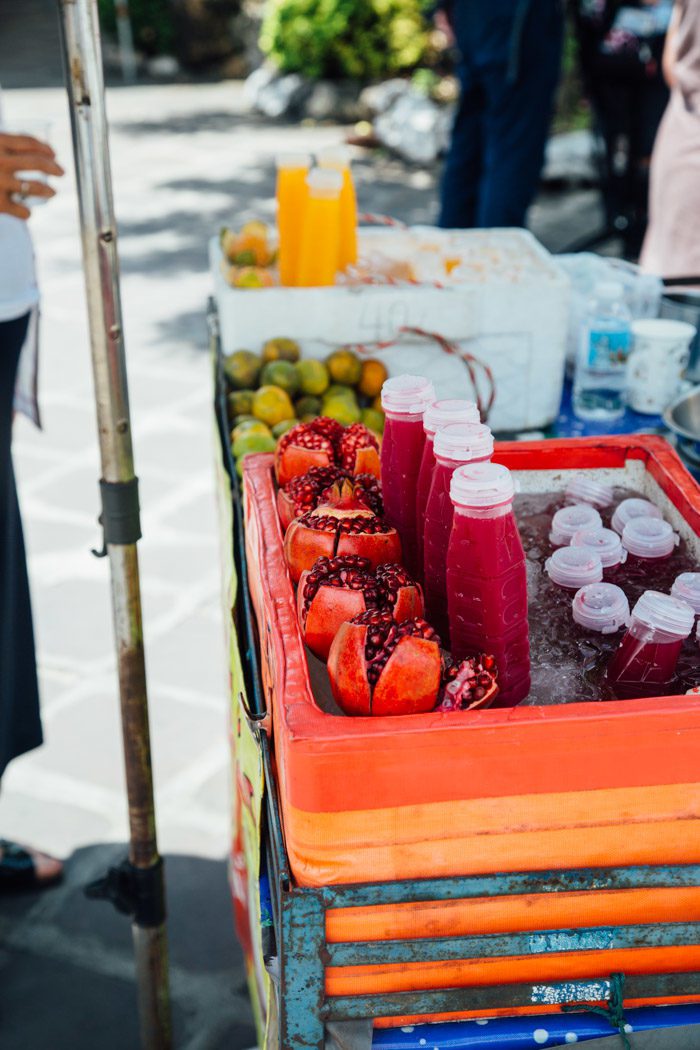
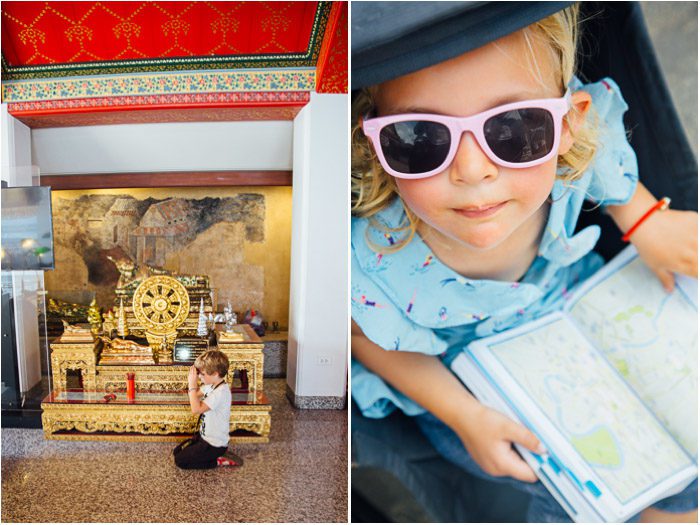
There’s a visitor center at the entrance to the Wat Po complex with some overviews and explanations of the temple’s layouts and history, as well as of Buddhist practices. For this reason, it might actually be helpful to start at Wat Po rather than the Grand Palace if you weren’t taking a tour.
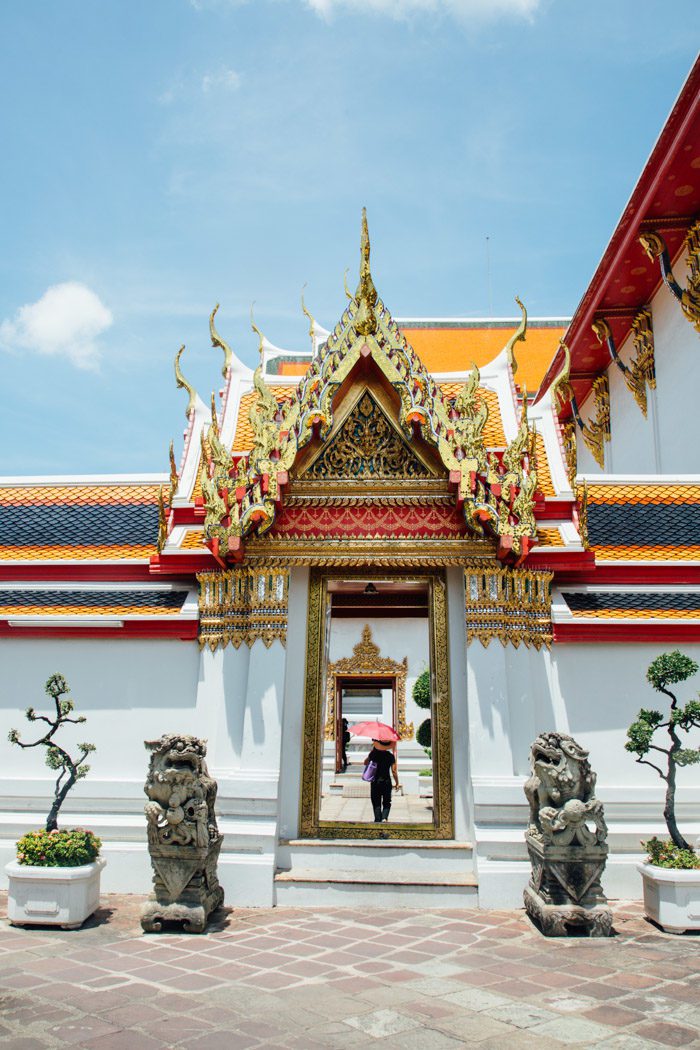
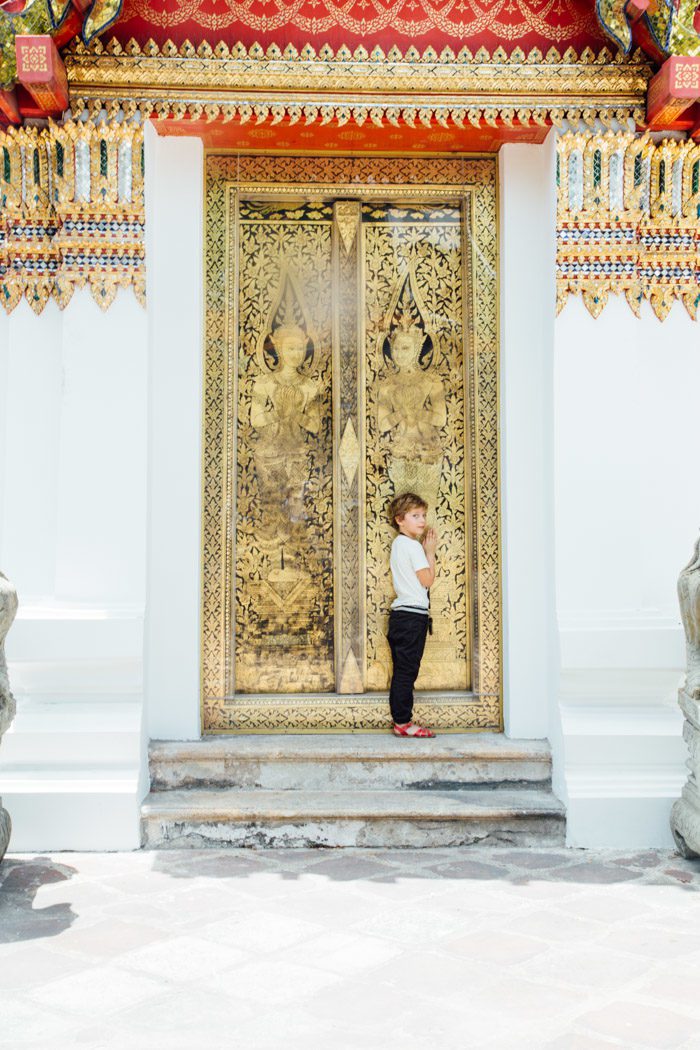
The kids got lots of practice making the Thai wai, a greeting that can mean hello, goodbye, or thank you, and which is done by placing the palms of your hands together and holding them close to and in front of your chest before lowering your head. Hudson and Aron would do this when saying sawatdee khap and Skyler and I while saying sawatdee ka (hello, masculine and feminine).
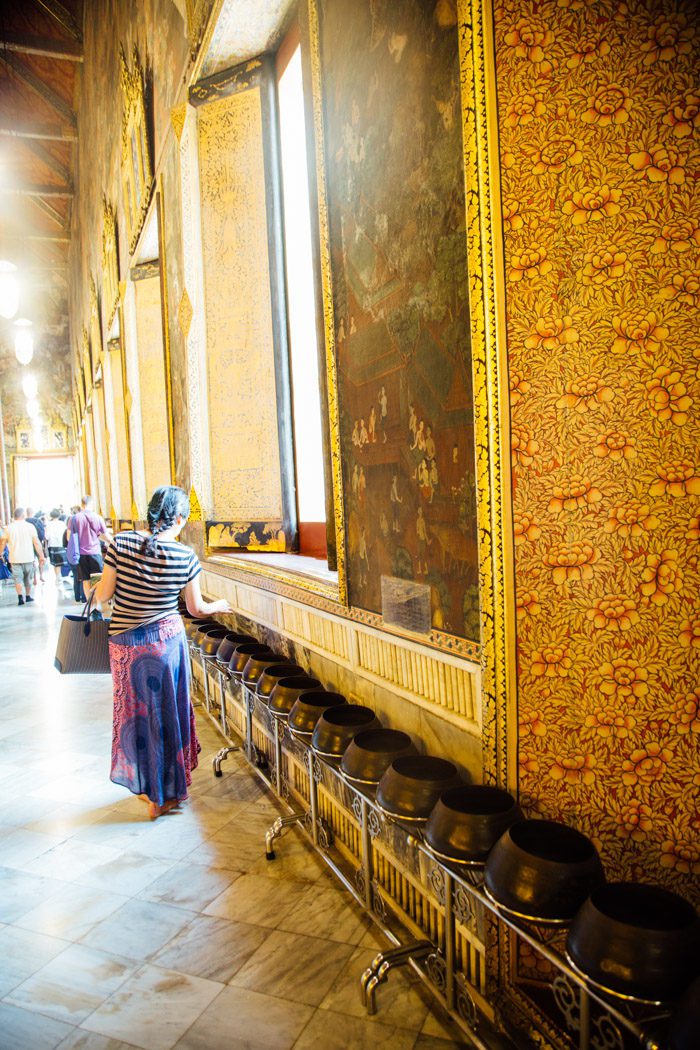
For a small donation, you can get a bag of 108 coins, one for each of the 108 bronze bowls in the corridor representing the 108 auspicious characters of Buddha. Dropping the coins is believed to bring good fortune. Of course, our children could be found on their knees, scouring the floor for extra dropped coins to return to the bowls.
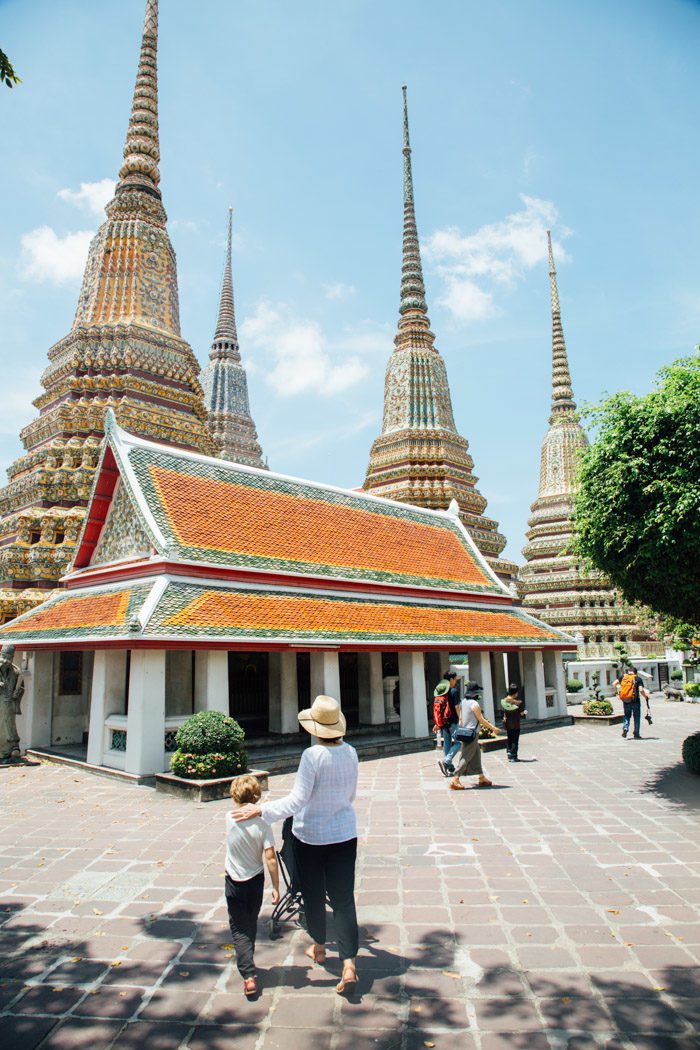
The Chedis (the tall mound-like structures containing relics) around the complex are magnificent—so colorful!
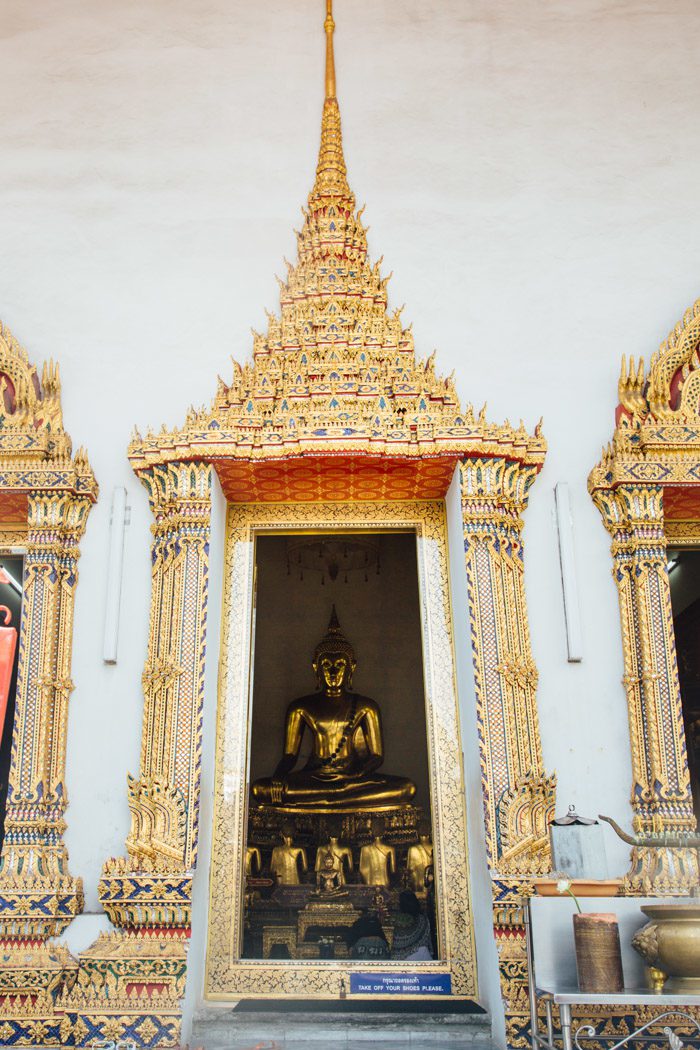
Though we were tempted to stay longer (perhaps even to get massages), we knew it would be wise to seek out lunch.
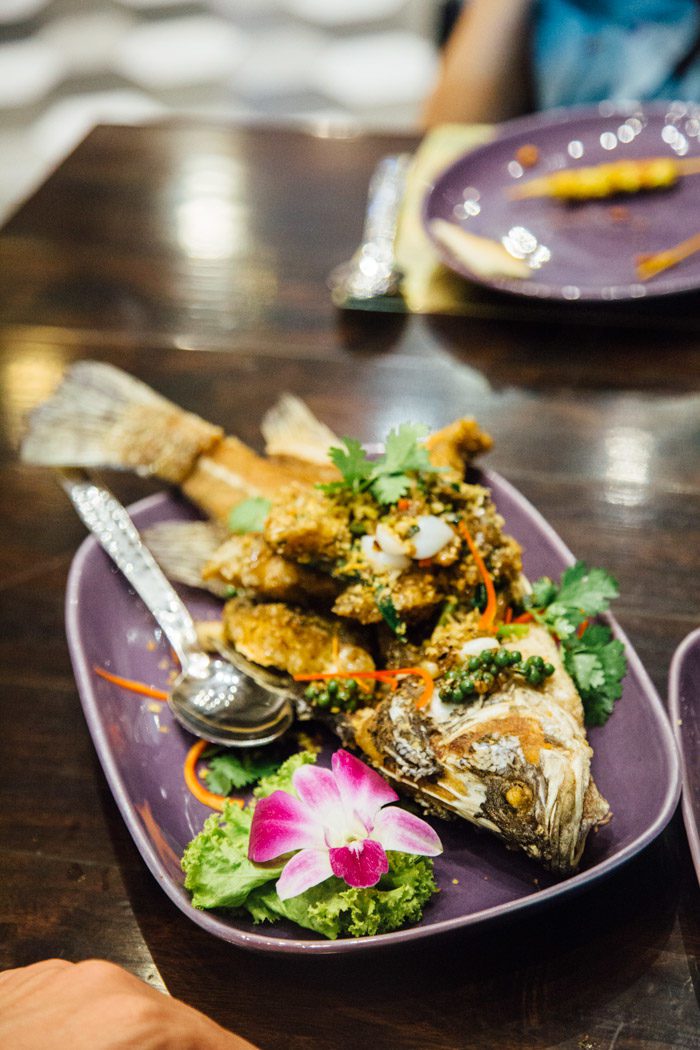
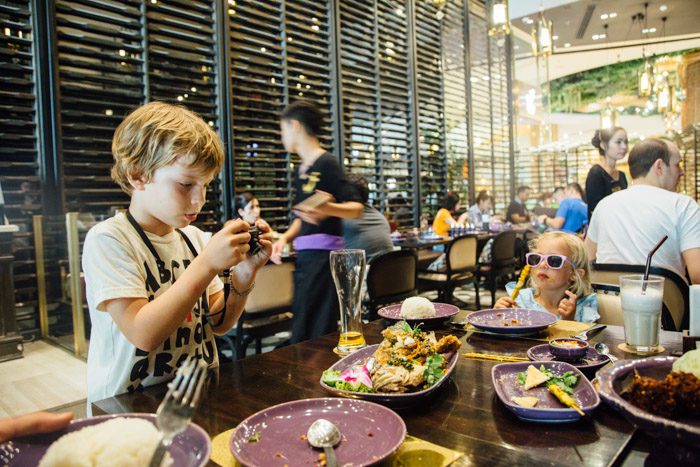
Malls are a big deal in Bangkok and there are some incredible food courts. For example, Terminal 21 has nine floors, each with its own geographical theme (one floor is Rome, another Istanbul, another is Hollywood); Central World, the largest, has a range of eateries as well as an ice-skating rink; the luxe EmQuartier has a rainforest inside. I’m sure there are many more.
We found our way to Siam Square, where one could get lost in an air-conditioned group of malls—from the MBK Centre to Siam Paragon—for days. We took a taxi to Paragon and entered beside a fancy grocery store with imports from all over the globe, and then passed by kiosk after kiosk of restaurants that were equally representative: I was so surprised to see a place called “Mission Taco” from San Francisco next to Clinton Street Baking Company from New York. Then there’s an actual food hall where you can load a card up with credit and choose from street-food-esque stands. It was equal parts intriguing and overwhelming.
We ended up at a restaurant when the kids spotted the whole-grilled-fish, fragrant with fresh green peppercorns.
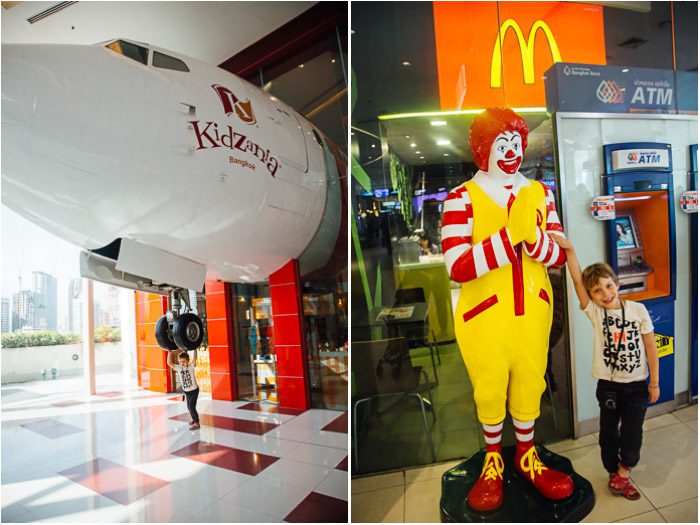
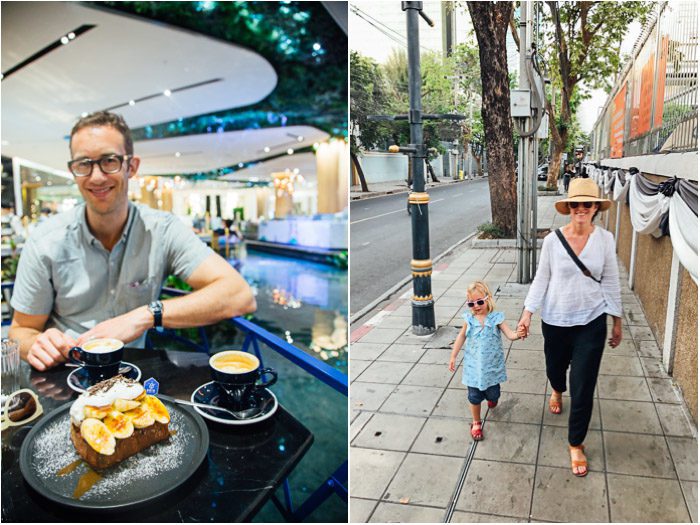
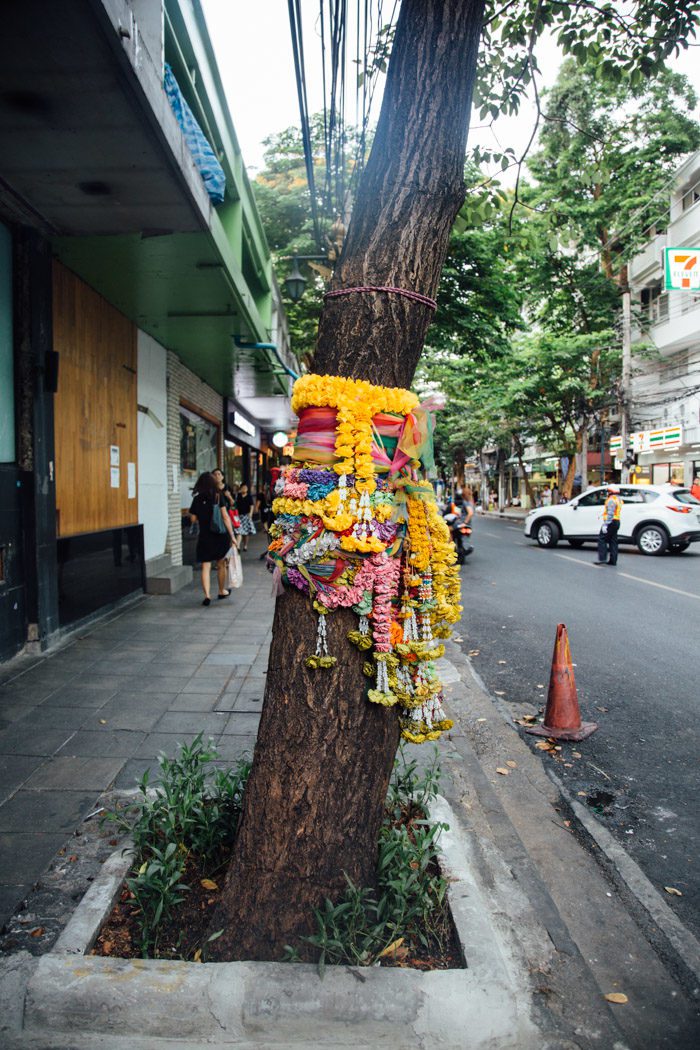
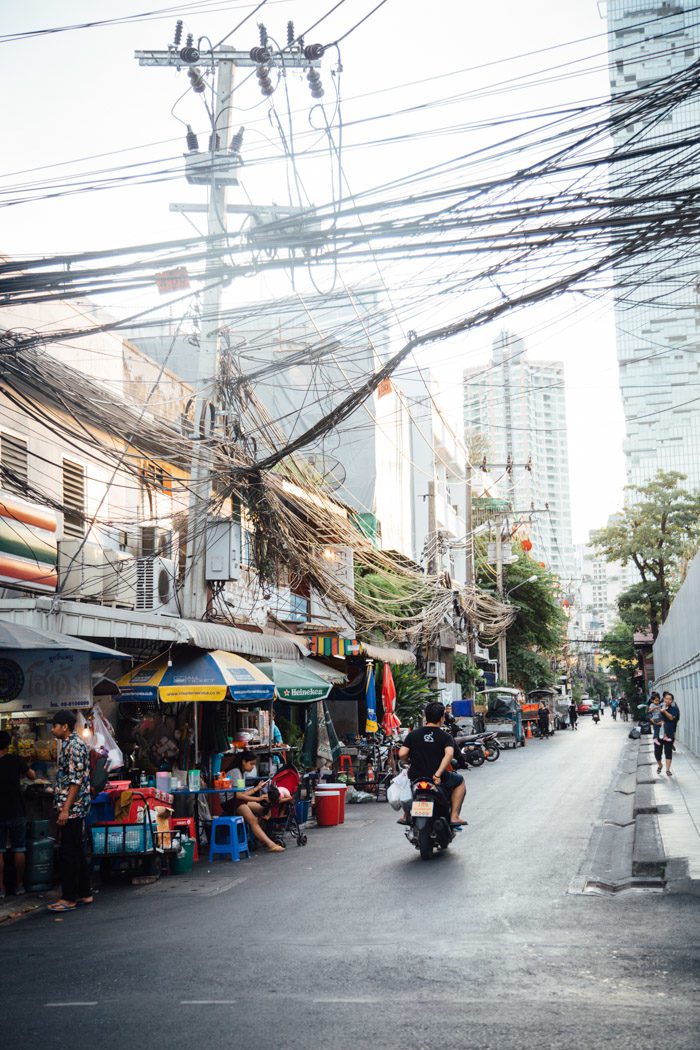
Just walking was always a treat for the senses. Telephone wires formed canopies along storefronts in precarious looking jumbles. Motorbikes zoomed around corners. And families stopped at carts lining the sidewalks as geckos would scurry out of the way.
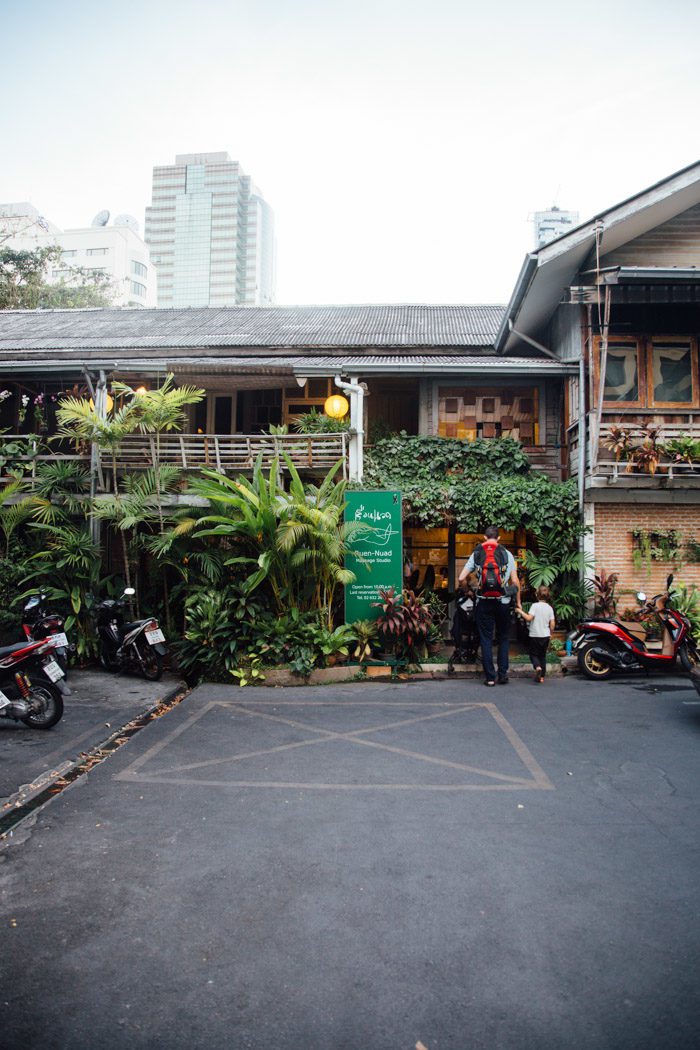
Rather than head back to the hotel we sought out a massage spot that had been our favorite on our honeymoon: Ruen-Nuad. There are options for massages all over the city, from pricey/fancy hotel spas to little roadside rooms. Ruen-Nuad seemed to straddle the line in the best way: totally unfrilly and inexpensive, but quiet and comfortable. You change into pajamas and go into little studios.
So the kids got to watch a show and play a few video games in a juice bar downstairs while we traded off for massages. Aron chose the 30 minute foot massage and I chose the full-body Thai massage.
I was sore for days! I’d forgotten just how intense it can be. There were definitely a few times when I considered crying Mercy. And yet it was the sort of addictive pressure and stretching that made me seek out something comparable for the rest of our stay. No other massage quite had that hurts-so-good quality as this place. It definitely felt like it could be categorized as “experience” as much as pampering.

We stopped for some street food on the way back, and then Skyler was out again! It made the bedtime routine pretty simple.
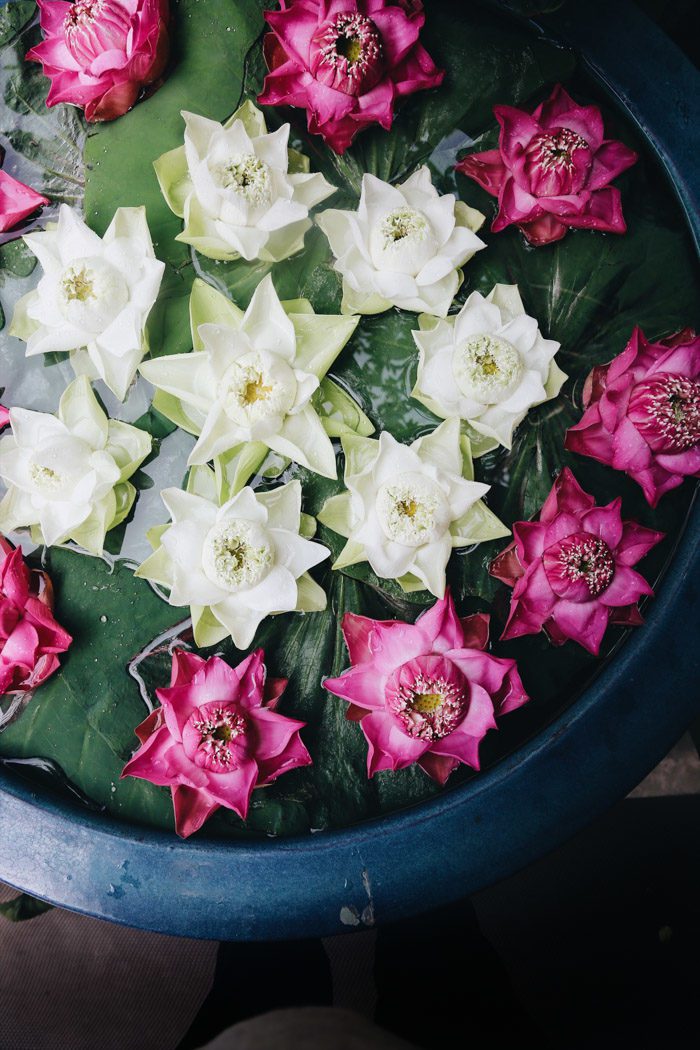

The following day took us back on the SkyTrain in the direction of the khlong from where we’d caught the ferry. Only this time, we instead headed down a side street to the Jim Thompson house. Employed in Thailand during WWII (as a sort of CIA agent), Jim Thompson was an American who settled and started a silk business here before disappearing on a trip to Malaysia. As a result, his home is like a time-capsule, with all of his collections of art and furnishings on display. The teak traditional house was actually a composite of multiple homes, transplanted there; it and the grounds were lovely.
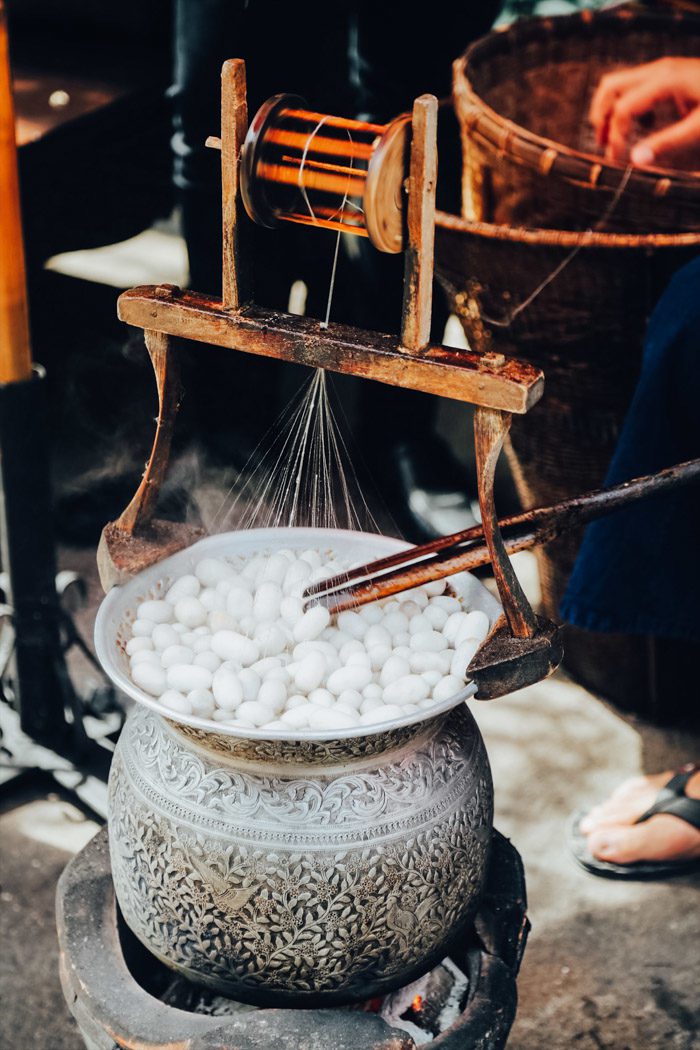
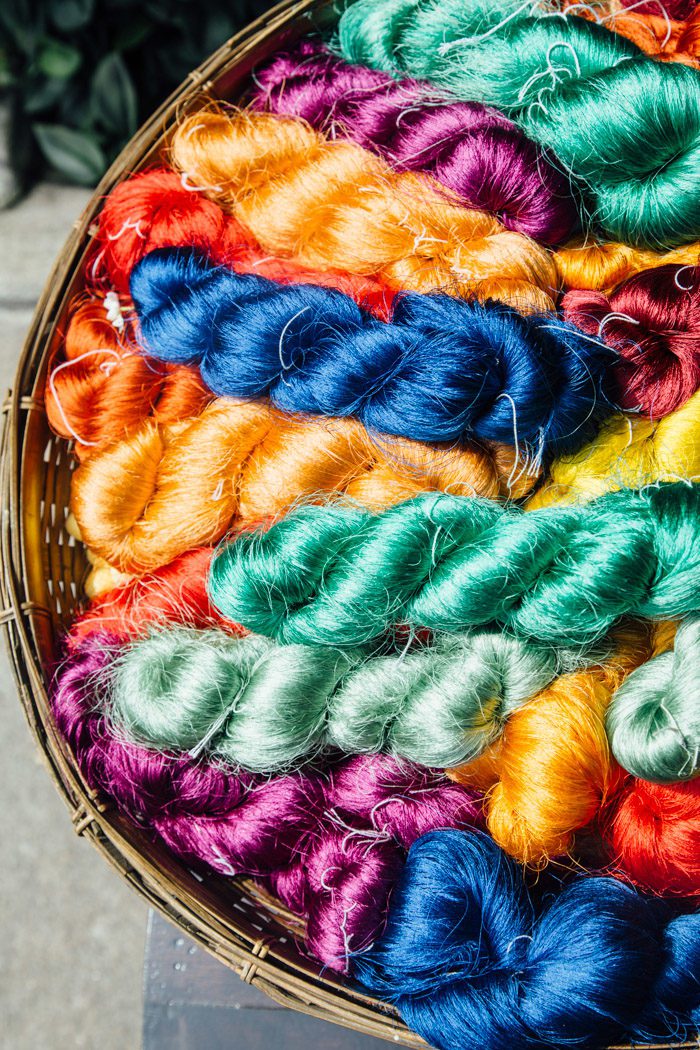
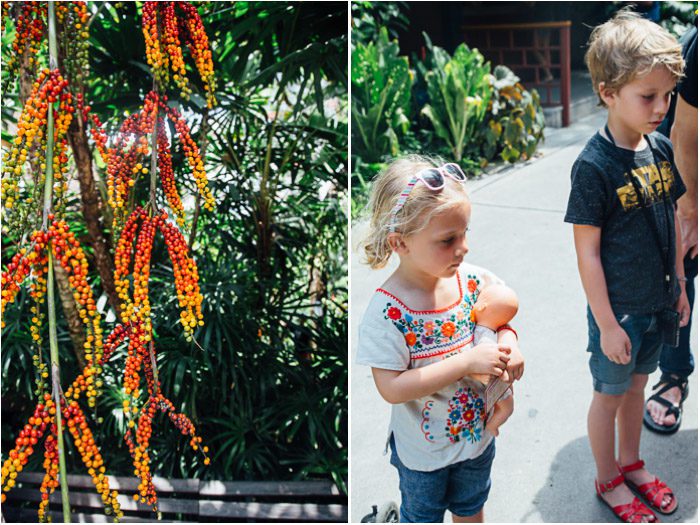
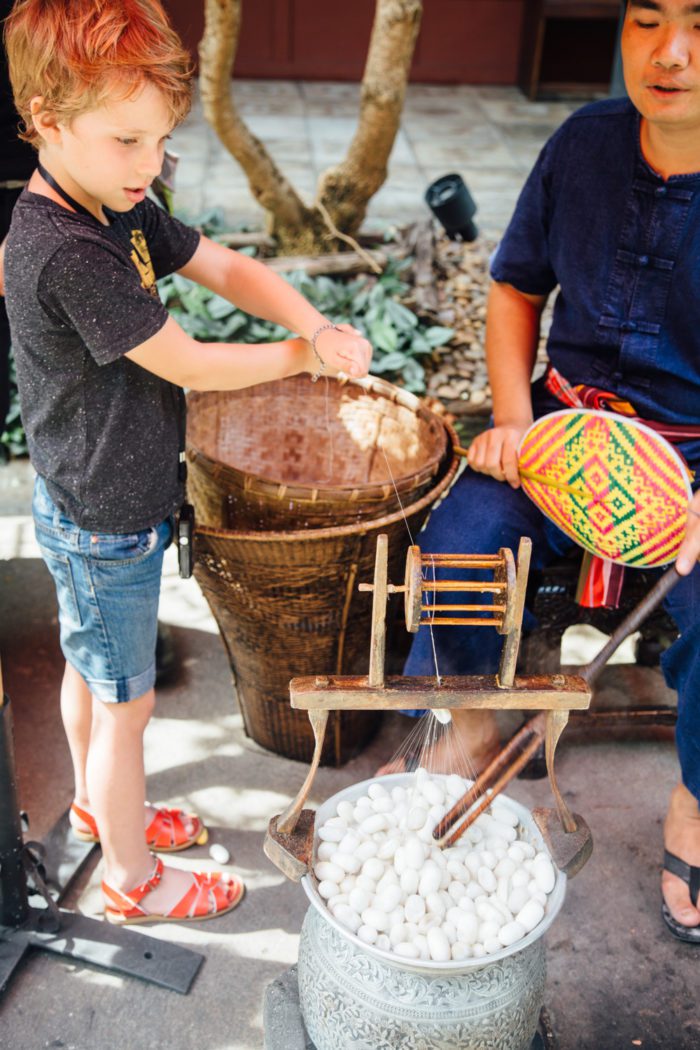
Guided tours are mandatory (and included), but there was plenty to look at while we waited.
In fact, one of the best parts of the visit was seeing the silk worm cocoons being processed into silk. Both kids have tended to silk worms in their classrooms, watching them cycle into moths, so it was perfect for them. Hudson even helped spool the boiled threads while Skyler looked on from a safe distance. It would be worth a visit for this demonstration alone.
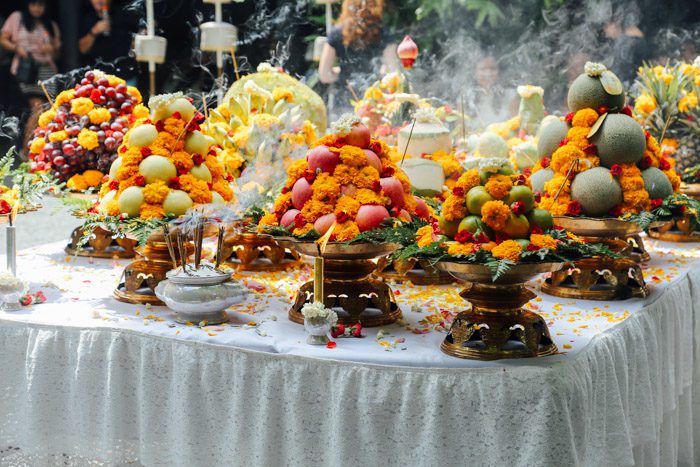
And it happened that we arrived on what would have been Thompson’s 110th birthday, so we witnessed a celebration in his honor—the air filled with music and with fragrant incense as special guests brought offerings to a table in the courtyard.
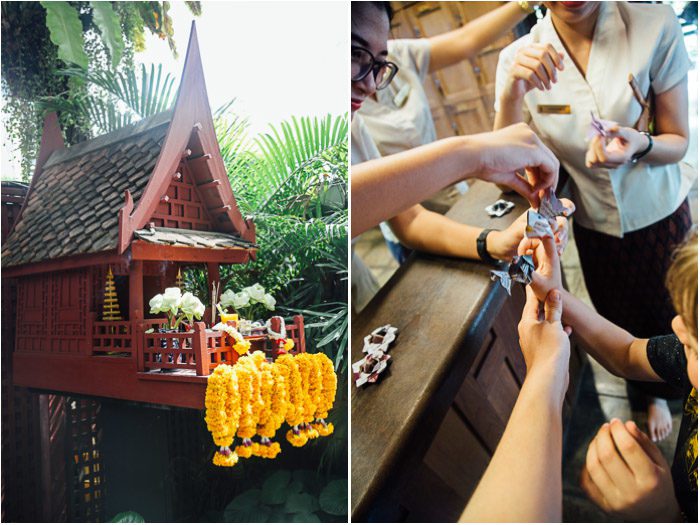
Touring the house itself isn’t the ideal kid-activity—even with items like chamber pots, which were fascinating to Hudson. Skyler was particularly difficult with all of the no-touching rules, but everyone was so kind to them. All of the docents gathered around them and made origami fish—like the Koi in the ponds around the house—for their fingers.
I think if one were nervous to take small children inside, you could switch off. I could have easily passed the 30 minute tour outside with them while Aron went inside and vice versa, if need be.
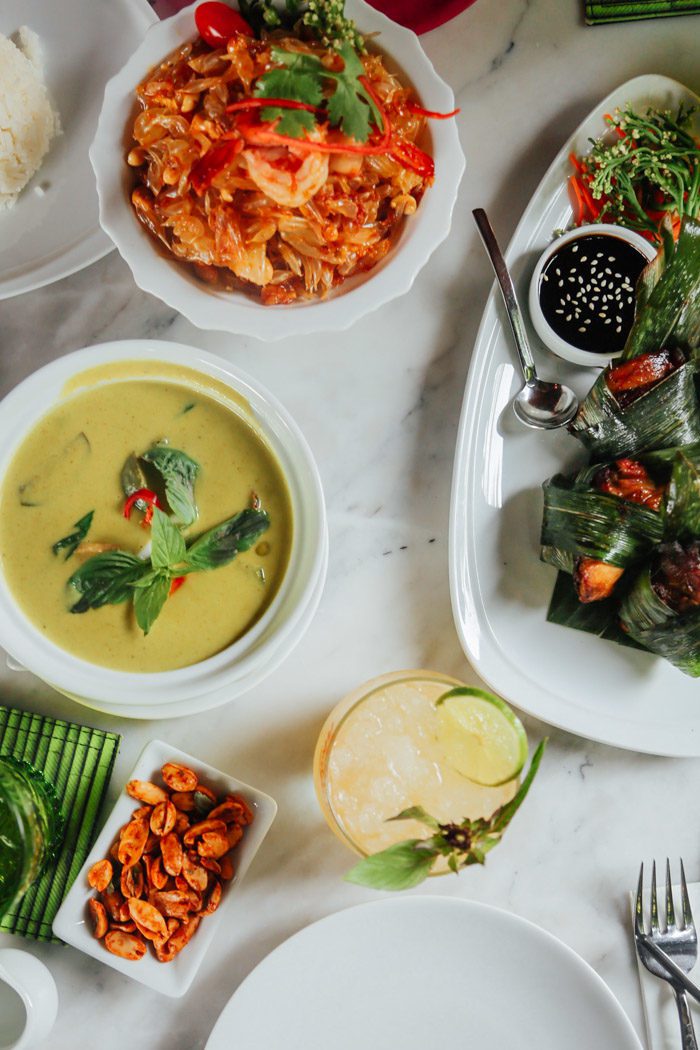
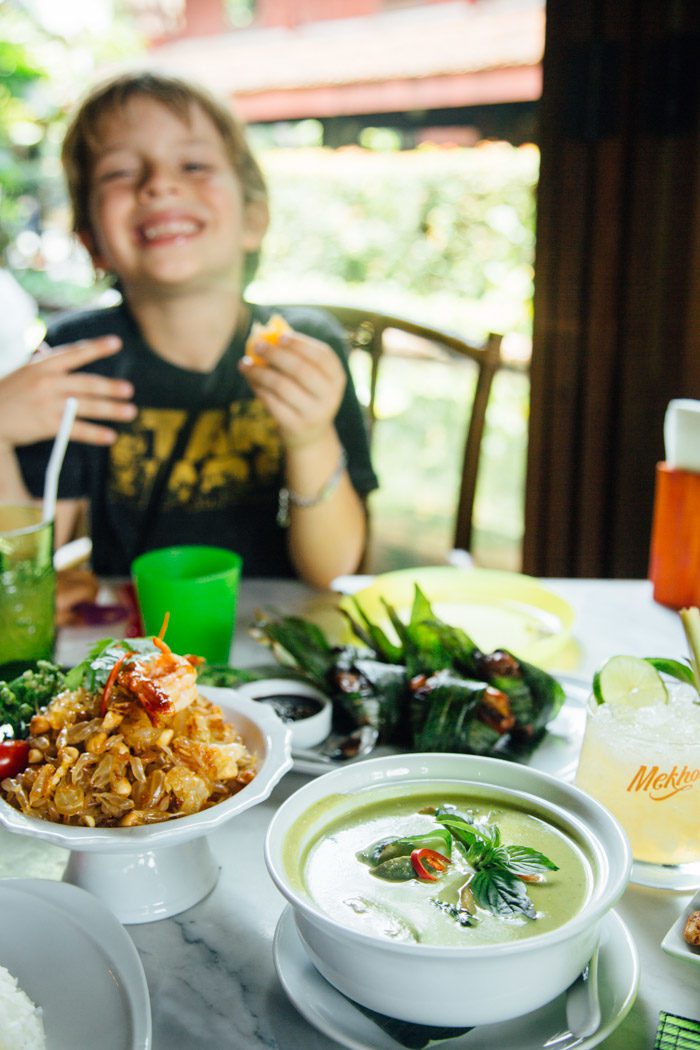
The restaurant on-site smelled amazing and was right beside a pond with fish and frogs and turtles, so we decided to stay for lunch. It was the first time we’d had the classic, seasonal Thai dish of Pomelo Salad—and it was amazing. Sweet, acidic pomelo, peanuts, chili, lime, fish sauce, tiger prawns… just so fresh and delicious. Everything was very good.
Afterward, we went back to the hotel for a swim and a short break before heading out for a night market tour.
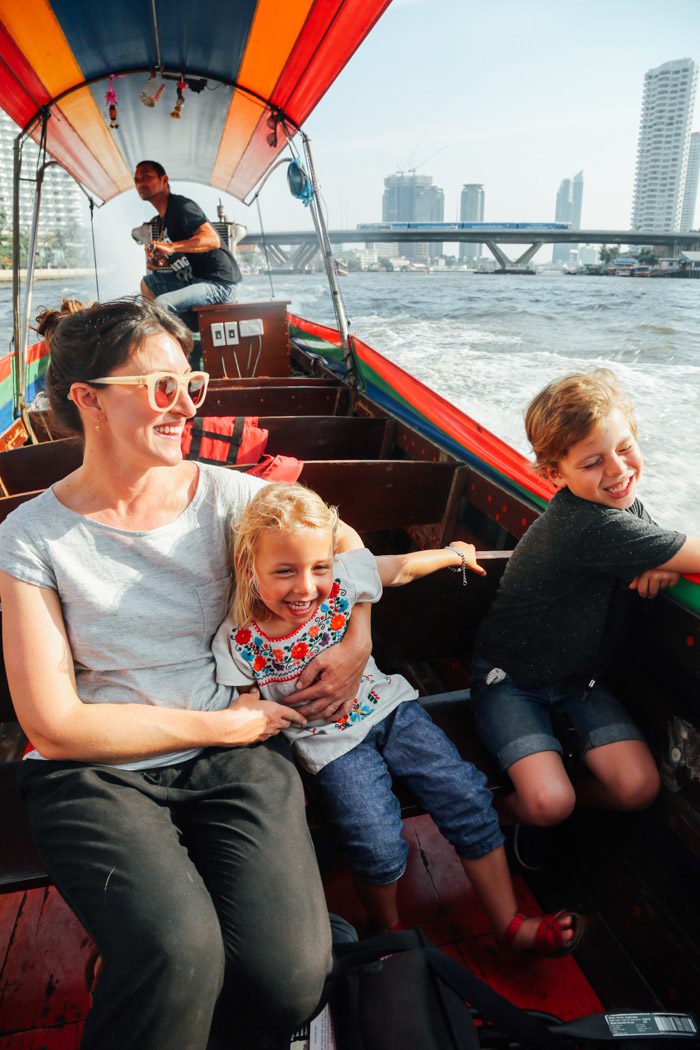

Hudson had been asking to take a longtail boat and we really wanted to let the kids have that pleasure of zipping down the river. Riding in one is a lot of fun, even though they’re quite loud and getting splashed is a risk (not a pleasant one), but it’s actually unusual to hire a longtail for a just a short ride. Most are used for tours, and the prices are geared for tourists. However, because it was late in the day, we were able to negotiate one for a brief distance, and it was well worth it!
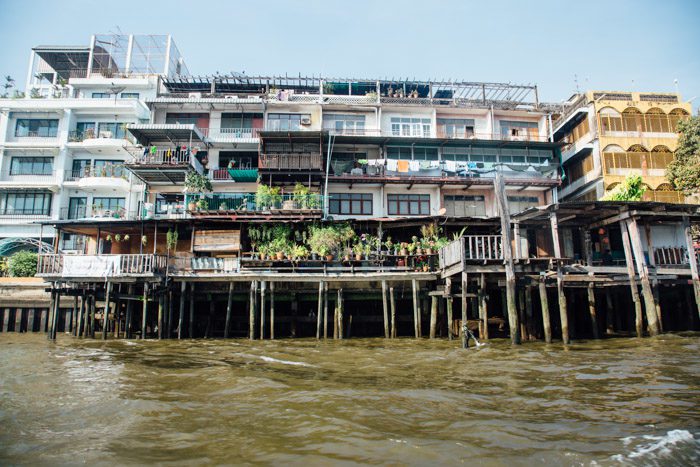
That reminds me: earlier that day, or perhaps the previous, as we were passing these houses on a commuter boat, the kids were asking about whether anyone swims in the river. We explained that some do, but then went into the risks of the currents and the boat traffic and the water… etcetera. Just then, we looked to the side and there was a dead body in the river! “He swimming!” said Skyler. “Why he swimming?” Neither she nor Hudson had any idea.
Later, someone even mentioned to them that no one really swims in the river, and Skyler replied “but some people do.” “That man swim.”
I did some searching later to see if anything was written about a found-body, but I don’t think we’ll ever know any more.
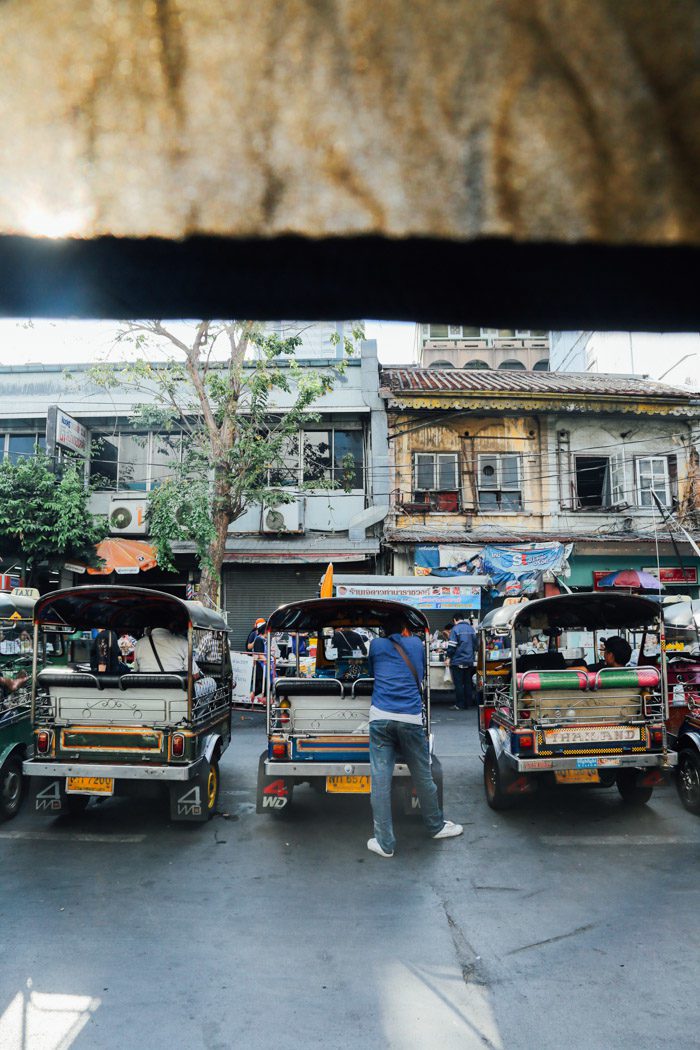
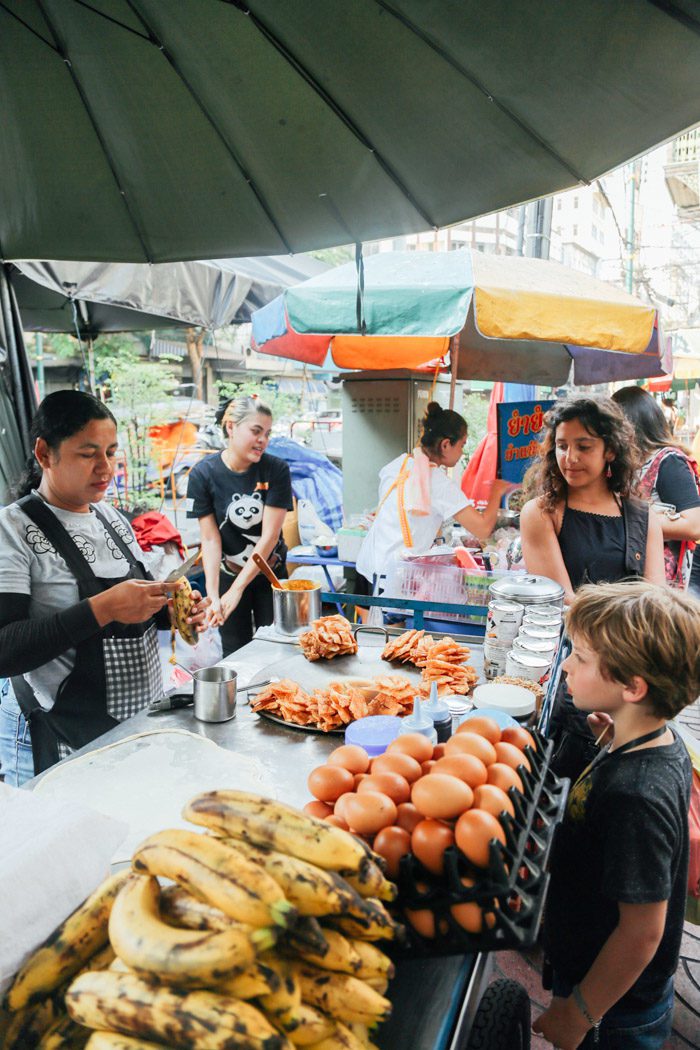
We arranged a street/night market tour with the same company, Context Travel. A cook from the UK, now living in Bangkok, named Gary was to be our guide for the evening. We had the longtail drop us just outside of Chinatown, where we would meet him. It wasn’t long before we spotted a sweet Roti stand, so we grabbed a pre-tour snack of our own.
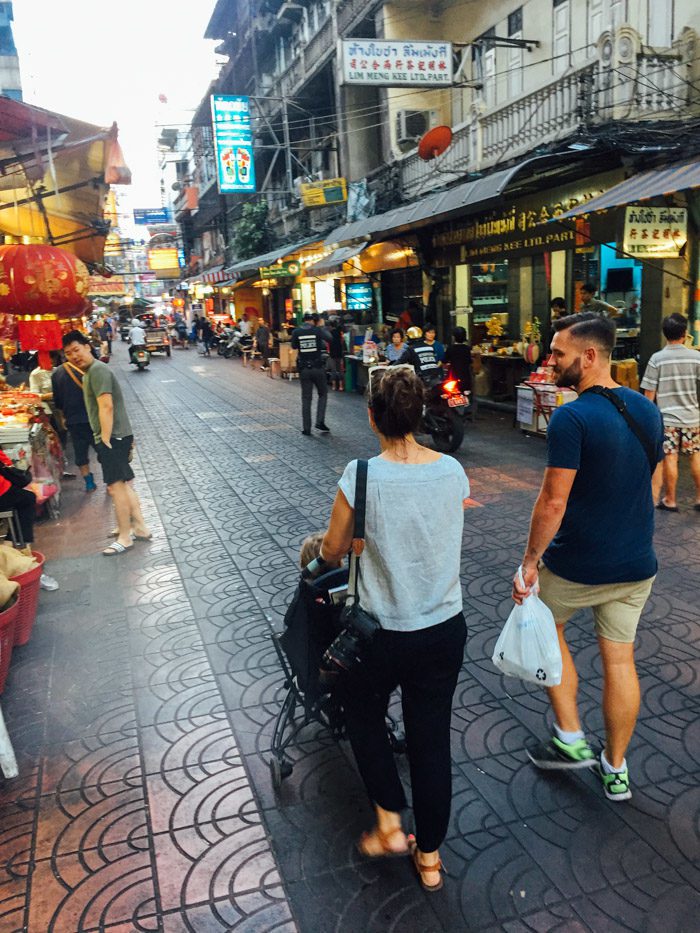
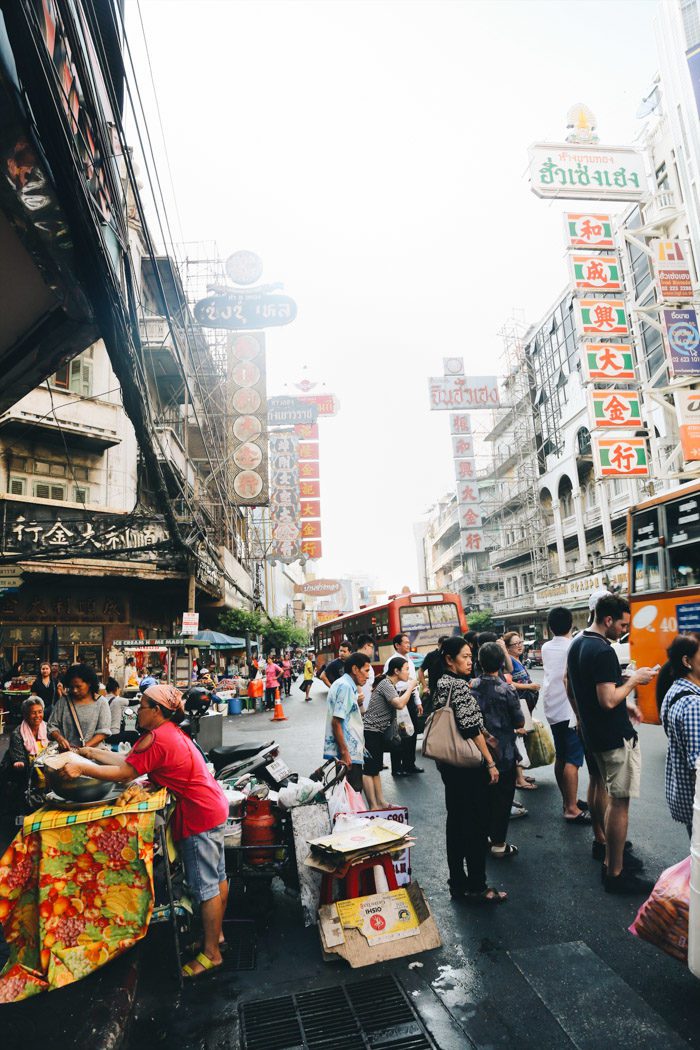
Yaowarat, the local name for Chinatown, was established when a large Chinese community was relocated to make way for the Grand Palace in Ko Rattanakosin in the late 18th century. It’s totally overwhelming and chaotic, lively and crowded and exciting… and arguably one of the best places in the city for street food.
We were happy to have a guide to help us navigate it in all senses, including getting across the street!
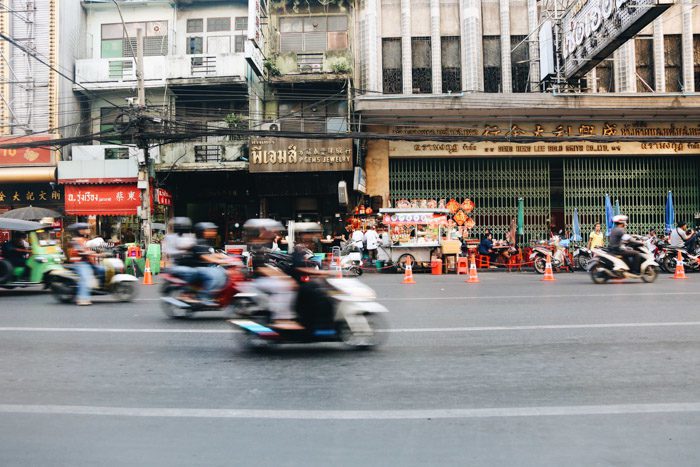



Gary walked us through some tight alley-way markets and pointed out the most common ingredients that give Thai cooking its heat and its flavor before stopping at Khao Gaeng Jake Puey, a rice and curry stall that has become relatively famous for its curries, rushed over from a nearby kitchen as fast as they’re made. The seating situation can resemble musical chairs as diners grab stools the moment one is free. High traffic and high turnover is one of the best tells for a good street-food find.
Both dishes we sampled, the Gaeng Moo (Southern style pork curry with sweet potatoes and rice) and Khanom Jeen Gaeng Keow (chicken green curry with rice noodles), were wonderful—if a bit spicy for the kids.

Passing roasting chestnuts and piles of pineapples along the way, our next stop, Kha Moo Siri Rama, was exactly the kind of place we’d never have looked twice at without a guide—and we’d have been missing out.
Khao Kha Moo—braised pork leg on rice—is one of those ubiquitous dishes served by street vendors throughout Thailand; we’d been seeing it around, but didn’t really know how to approach it. It looks simple: stewed pork with spices over a bed of rice, and some meaty stew. But the flavors were anything but. Fatty pork skin, pickled greens, garlicky sauce, and some hard-boiled eggs were offered up with bowls of green chilies, for an incredible combination.
Likewise hiding in plain sight, our third stop was to get fried chicken wings on a skewer with sweet chili sauce (Peek Gai Tod) from a little cart in the middle of the street at Sampeng Lane market. I don’t know that I would have been drawn to fried chicken on a cart, but it was the best fried chicken I can remember. For one thing, it was fresh. But the batter was salty and light and it paired perfectly with the chili sauce.
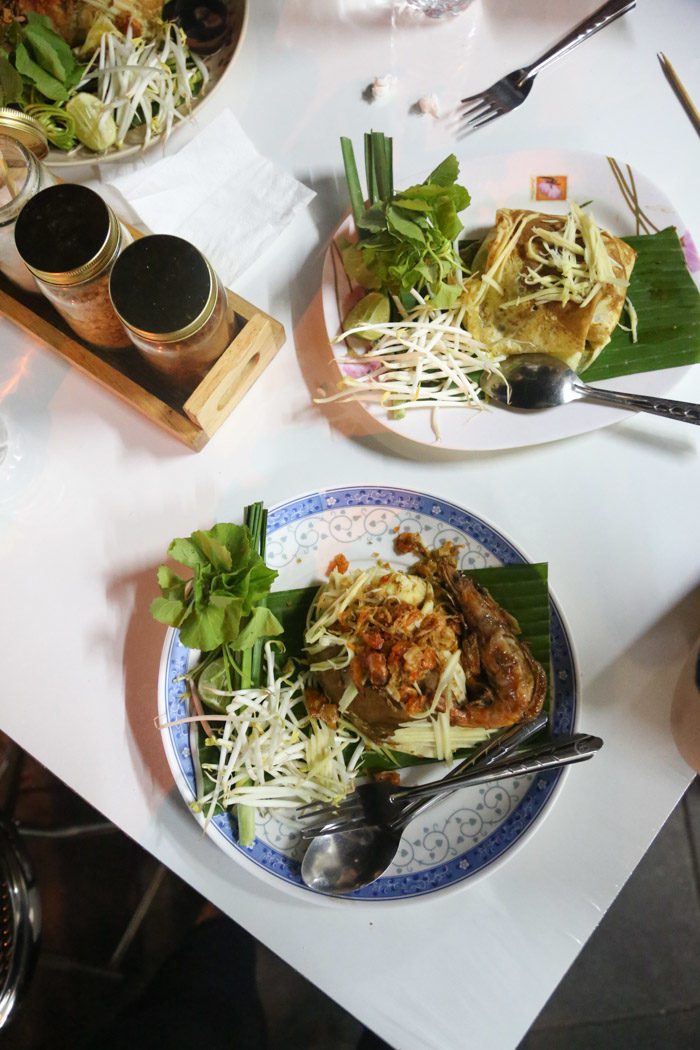
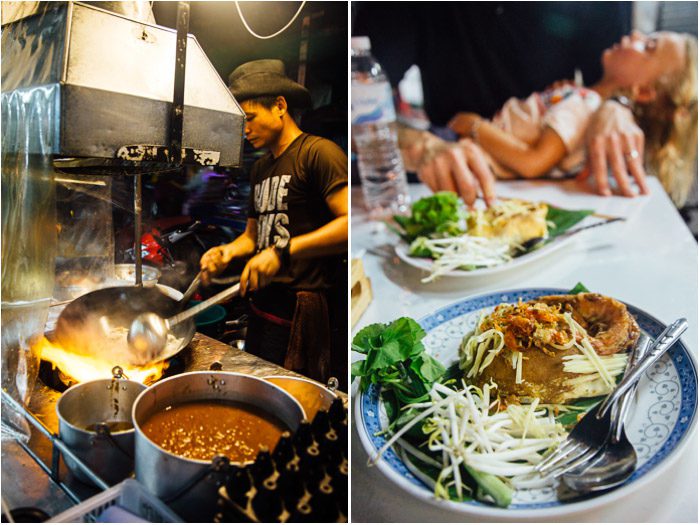
From there, we all hopped on a Tuk Tuk over to Charoen Rat Road (by Wongwian Yai) to sample Gary’s favorite Pad Thai—which apparently isn’t a common dish among the Thai, being more an item ordered by Westerners. The most famous place to have it in Bangkok is called Pad Thai Thip Samai, but we were assured that this was the one to try.
Rather than scramble eggs into the noodles, a thin layer of beaten egg is swirled around like a crepe in the flaming wok for making a little package around the noodles. Our was topped with giant prawns—Pad Thai Goong.
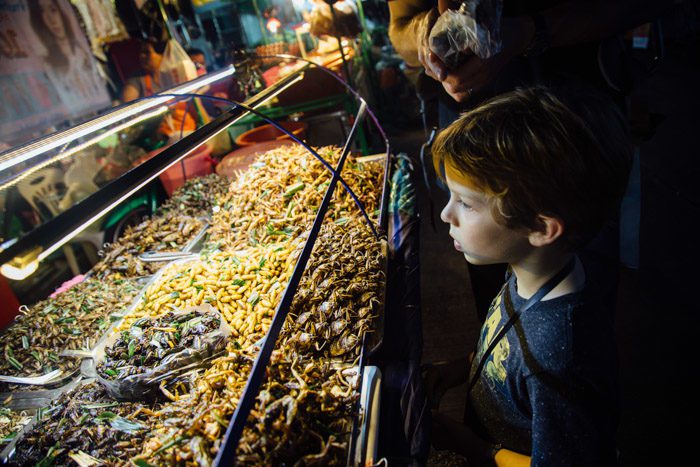
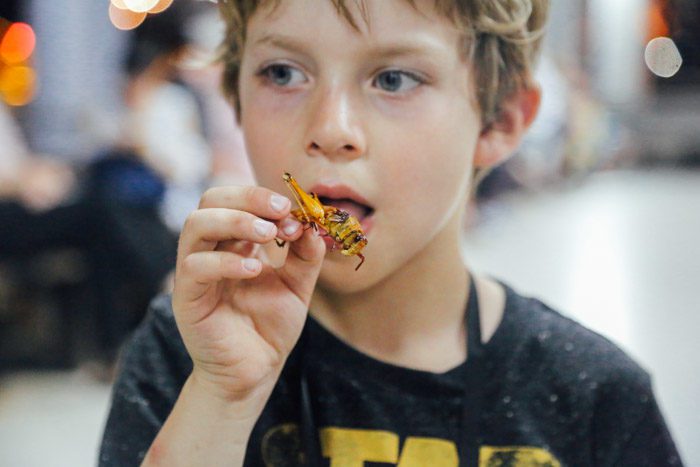
Skyler fell asleep while we were finishing up our noodles, but we had one last stop.
We ended our evening at the busy Bang Rak Market for another sweet Roti (this time green from pandanus palm leaves). While there, we happened upon a stand selling fried bugs—grasshoppers, caterpillars, beetles, all sorts of things—that you could request squirted with soy sauce. Though he wasn’t tempted by the Pad Thai, Hudson was eager to sample the fried creatures. With no urging whatsoever, he ate a couple of caterpillars, but preferred the giant grasshoppers for their crunch. Gotta give him credit! That was one stop on the food tour that I let pass.
Stomachs full, we slept well that night—a good thing because the next day we would leave early for our next destination, Khao Sok National Park where we were going to meet some elephants!
A few more random notes on Bangkok:
We loved staying at our hotel by the river. It really was a wonderful place to be with the kids. But getting back and forth across the river did also add travel time to every outing. Many people prefer a more central skyscraper—for this reason, as well as for the pleasure of rooftop pools and bars. Our hotel did also have a kids’ club, however, for ages four and over that we could have used for activities during the day.
Also, we had a long list of restaurants and attractions on hand that we never made it to. Time Out Bangkok is a great online resource for current listings of more cool/trendy places to try, and of shops to visit. In hindsight, we might arrange a babysitter for at least one night to fit in a night market and a visit to a rooftop bar, but then again, who are we kidding?—we rarely lasted much later than the kids.
Have you been? What would you add?
Next up: Khao Sok National Park, Ko Yao Noi, and Phuket.
Previously: Bangkok (Part 1)


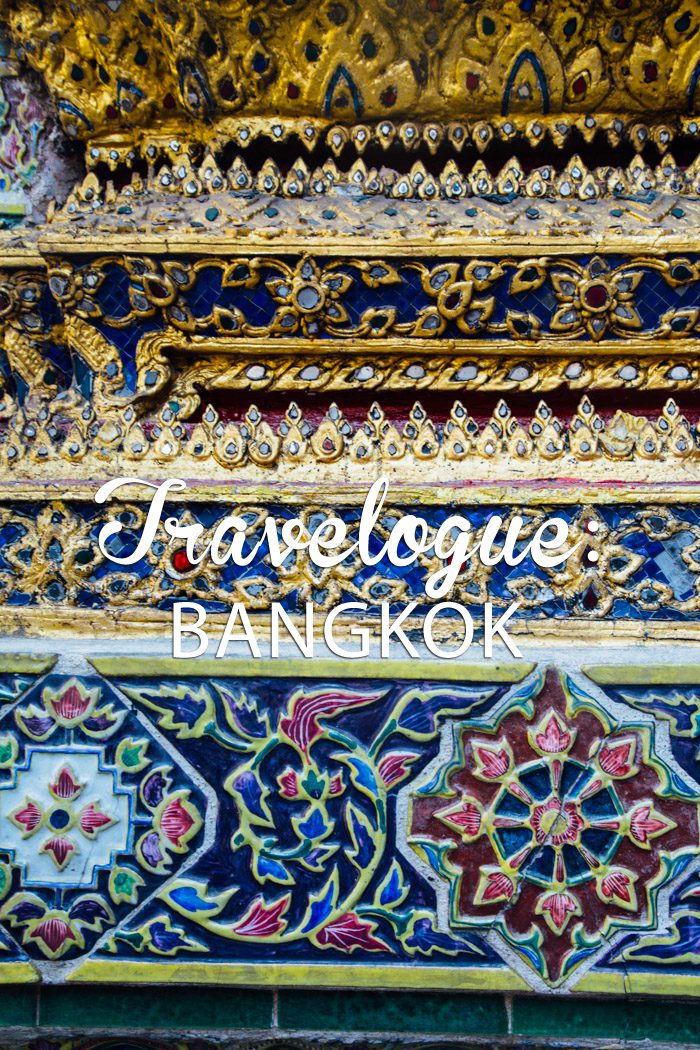

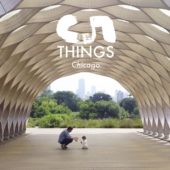

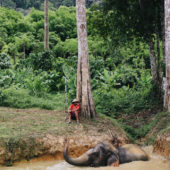











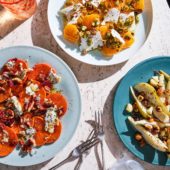
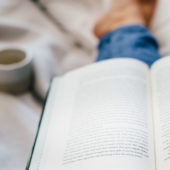


















27 Comments